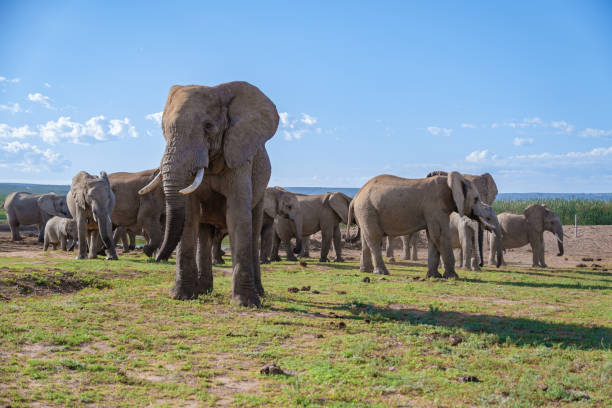When people think of Addo Elephant National Park, the first image that comes to mind is often its impressive population of elephants. Located in the Eastern Cape of South Africa, Addo is famed for its role in conserving these majestic creatures. However, the park is home to a stunning variety of wildlife and habitats, making it one of South Africa’s most ecologically diverse national parks.
In this article, we’ll explore how Addo Elephant National Park protects more than just elephants, its contribution to biodiversity conservation, and the other unique species and habitats you can find within its boundaries.
A Brief History of Addo Elephant National Park
Established in 1931 to protect the remaining elephants in the region, Addo originally covered just 2,270 hectares and was home to only 11 elephants. Since then, it has expanded dramatically, encompassing nearly 180,000 hectares and now hosting over 600 elephants. While elephants are still central to the park’s identity and conservation efforts, Addo’s focus has broadened over the years to include a range of flora and fauna.
Addo is unique in being one of the few places in the world where you can find the Big Seven—an expanded version of Africa’s famous “Big Five” (elephants, lions, leopards, rhinos, and buffaloes) to include the great white shark and southern right whale due to Addo’s proximity to marine areas. This achievement is a testament to the park’s diverse ecosystems and habitats.
The Wide Range of Species Protected by Addo Elephant National Park
1. The African Lion
Addo is home to a small but significant population of African lions, reintroduced to restore the region’s natural predator-prey balance. The presence of lions not only enriches the biodiversity of the park but also contributes to the overall health of prey populations, helping to manage species like kudu and warthogs naturally.
2. Leopards and Other Predators
Although leopards are more elusive and less frequently seen, they are present in the park, often residing in dense thickets and highland areas. Other smaller predators include the spotted hyena, caracal, and black-backed jackal, which contribute to the ecological diversity of the park.
3. The Black Rhinoceros
Addo is one of the few parks in South Africa that offers a safe haven for the critically endangered black rhinoceros. These rhinos face threats from poaching and habitat loss across the continent, making Addo’s protected area essential for their survival. The park’s dense thicket vegetation provides ideal cover and browsing opportunities for these solitary herbivores.
4. Cape Buffalo
Once at risk due to habitat loss and disease, the Cape buffalo now thrives in Addo. Their presence not only adds to the “Big Five” appeal but also contributes to the park’s grassland ecosystem by grazing and shaping vegetation patterns.
5. Marine Life: Great White Sharks and Southern Right Whales
Addo Elephant National Park extends its conservation reach to marine life along the nearby coast. The marine protected area is home to great white sharks and southern right whales. The presence of these marine species is crucial for the coastal ecosystem, as both play essential roles in the health of marine life. The park’s protection efforts help safeguard these creatures from overfishing, marine pollution, and habitat degradation.
Biodiversity Beyond the Big Seven
1. Unique Flora
Addo is home to the regionally distinctive Addo bushveld and fynbos, both part of South Africa’s unique vegetation biomes. The Addo thicket is particularly rich in succulents, shrubs, and hardy trees that offer food and shelter for a wide range of herbivores and bird species. Fynbos, one of the world’s six floral kingdoms, is characterized by its colorful flowers and is a global biodiversity hotspot.
2. The Addo Flightless Dung Beetle
Perhaps one of the most unusual residents of Addo is the Addo flightless dung beetle. Found only in this region, it is one of the few dung beetles in the world that cannot fly. The beetle plays a critical role in the ecosystem by recycling nutrients, aerating the soil, and helping control parasite populations. To protect this beetle, the park even has “Dung Beetle Crossing” signs on roads to prevent vehicles from harming these unique insects.
3. Antelope Species and Other Herbivores
Addo is home to various antelope species, including kudu, red hartebeest, eland, and bushbuck. These herbivores are important for maintaining the balance of vegetation in the park and serve as prey for larger predators. The zebra and warthog populations are also thriving in Addo, and they contribute to the park’s ecological balance.
4. Birdlife
The park is a bird-watcher’s paradise, hosting over 300 bird species. From the elegant African fish eagle to the endangered Denham’s bustard, the park’s range of habitats supports diverse avian life. Wetlands, open savannas, and dense thickets create ideal conditions for both resident and migratory bird species.
Ecosystems and Habitats Protected by Addo Elephant National Park
Addo’s conservation efforts are focused on more than just species; the park protects various habitats and ecosystems that support a broad spectrum of wildlife:
-
Coastal and Marine Ecosystems: The marine protected area conserves coastal waters, offering protection to marine life such as sharks, whales, and even smaller species like fish and crustaceans, all of which contribute to the ecological health of the marine ecosystem.
-
Thicket Biome: This dense, woody vegetation is distinctive to the Eastern Cape region and provides crucial shelter and sustenance to herbivores like elephants and black rhinos. The thicket also acts as a carbon sink, helping reduce carbon dioxide levels in the atmosphere.
-
Savanna and Grasslands: Open savannas and grasslands support a range of herbivores and bird species and provide hunting grounds for predators. This diverse landscape is essential for grazing animals and offers great viewing opportunities for visitors.
Addo’s Role in Conservation and Ecotourism
By protecting such diverse species and habitats, Addo Elephant National Park contributes significantly to South Africa’s conservation goals and biodiversity. The park’s expanded mission makes it a top destination for ecotourism, attracting wildlife enthusiasts, photographers, and nature lovers from around the world.
-
Research and Education: Addo provides a valuable space for ecological research on species and habitats, informing conservation strategies nationwide. Educational programs are also run to promote awareness about wildlife conservation.
-
Community Engagement and Job Creation: The park’s conservation activities create job opportunities for local communities in areas such as park management, guided tours, and hospitality, helping support the local economy.
-
Combatting Threats to Wildlife: The park’s expansion into marine and diverse land habitats helps reduce the impact of human encroachment, poaching, and other threats to wildlife. Addo’s anti-poaching initiatives and ranger programs are crucial in protecting vulnerable species like rhinos.
Conclusion
Addo Elephant National Park goes far beyond protecting elephants. Its commitment to safeguarding a wide variety of species, from the Big Seven to unique flora and the flightless dung beetle, makes it one of the most ecologically significant parks in South Africa. By preserving diverse ecosystems and engaging in community-centered conservation efforts, Addo ensures the protection of its rich biodiversity for generations to come.


